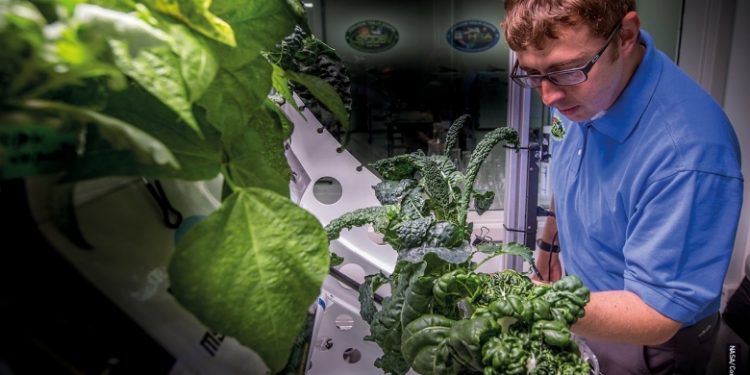The launch of NASA’s Artemis 1 mission to the Moon in November marked another step on the journey that will one day lead to humans visiting our nearest planetary neighbour, Mars. A human mission will eventually follow on the heels of multiple robotic spacecraft, the most recent of which was the landing of the Perseverance rover on the red planet in February 2021. For human trips to Mars there are many technological issues to be solved, key among them being the protection from solar radiation and crew health, including how best to provide nutritious food. The focus and challenge for many experts studying the latter is how to avoid the latent deficiencies caused by the constant consumption of freeze-dried food. The availability of fresh food will obviously be a major health and psychological advantage, and for this it will be necessary to grow and harvest plants en route. In this article, the authors review current data and research regarding nutrition, medical and psychological benefits, and possible methods of growing crops in deep space.
According to NASA, five major hazards appear during long spaceflights: space radiation, isolation and confinement, distance from Earth, low gravity, and the hostile and closed environment of a spacecraft. Living plants and freshly grown food could play a major role in supporting three of these: nutrition, medical needs and crew psychology.
Nutrition
The nutritional balance of food supplied for space missions must be perfectly adapted for a crew to sustain a long journey in good health
The nutritional balance of food supplied for space missions must be perfectly adapted for a crew to sustain a long journey in good health. As resupplies from Earth will be difficult, determining exactly the right diet and its precise form is a critical goal.
Avoiding any deficiency of essential nutrients is the most obvious challenge, and detailed nutritional needs have been studied by NASA. Much of the current space food ‘system’, however, has been proved to be deficient. Specifically, the long ambient storage of food induces the degradation of vitamins A, B1, B6 and C.
Cumulative mean weight loss for astronauts is 2.4 percent per 100 days in microgravity, even with stringent resistive exercise countermeasures. Astronauts have also been shown to suffer from nutritional deficiencies in potassium, calcium, vitamin D and vitamin K because food supplied does not allow them to meet the daily intake requirements.
Plants naturally contain vitamins and minerals, and the immediate consumption of fresh food would avoid the problem of storage. Consuming them would therefore be a great supplement to freeze-dried food.
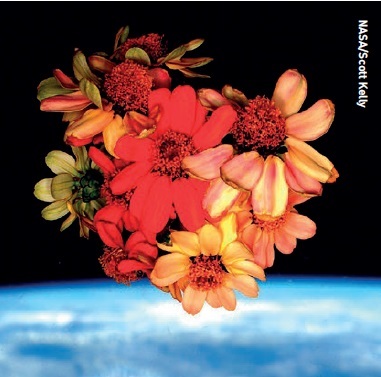 Astronaut Scott Kelly nursed dying space zinnias back to health on the ISS. He photographed a bouquet of the flowers in the Cupola against the backdrop of Earth and shared the photo to his Instagram for Valentine’s Day in 2016.
Astronaut Scott Kelly nursed dying space zinnias back to health on the ISS. He photographed a bouquet of the flowers in the Cupola against the backdrop of Earth and shared the photo to his Instagram for Valentine’s Day in 2016.
Medicine
In addition to vitamins and minerals, plants synthesize many different secondary metabolites. These compounds could be of great help in preventing health issues. For example, folate is involved in DNA repair, but its requirements are met on only 64 percent of flight days. As telomeres, the end of chromosomes, have been proved to be altered significantly during long flights, supplementation in folate via fresh plants could help reduce genetic aging and cancer occurrences.
Among other examples, carotenoid-rich vegetables could prevent eye distortion caused by microgravity, while a dried plum diet can help prevent radiation-induced bone loss. Many plants contain antioxidants that can be of great help in protecting human DNA from radiation-induced mutations. However, a plant-based diet is not sufficient and other solutions must be developed to protect astronauts from radiation.
Psychology
In addition to vitamins and minerals, plants synthesise many different secondary metabolites
As isolation and distance will place a significant strain on astronauts’ mental health, the meal is one of the most important times to lighten the mood. Eating freeze-dried food at every meal creates menu fatigue and astronauts tend to eat less over time. Eating fresh food can reduce this fatigue, not least in providing variety in form and texture.
Another activity beneficial to the crew’s mental health is horticulture. Growing plants has been proved to have tremendously beneficial effects, as it can give the astronauts a feeling of travelling with a piece of Earth. Some studies have tried to find the plants with the most beneficial psychological effects, as they could be a very important factor for the crew’s mental health. For example, strawberries may improve positive psychological responses, such as vigour and self-esteem, reduce depression and stress while coriander could improve sleep quality.
Thus, plant-based space farming is interesting on a nutritional, psychological and medical level. However, the lack of room and the particular growing conditions limits the number and the choice of crops.
The actual choice of crops used will vary, depending on the criteria examined and the field (nutrition, psychology and medicine) favoured. Some plants with a long shelf-life can be convenient, such as wheat or potato, but have the disadvantage of needing to be cooked before consumption. Another factor to consider is the reproductive system and the pollination mode of the plants, because animals (such as insects) are not allowed on board.
A list of potential crops to grow in space was established, some of which had already been cultivated on board. The authors selected nutritional and agronomic criteria as tools for choosing them. Thus, for psychological effects, a value from one (min) to four (max) was attributed to the taste and appearance of the crop or edible plant part.
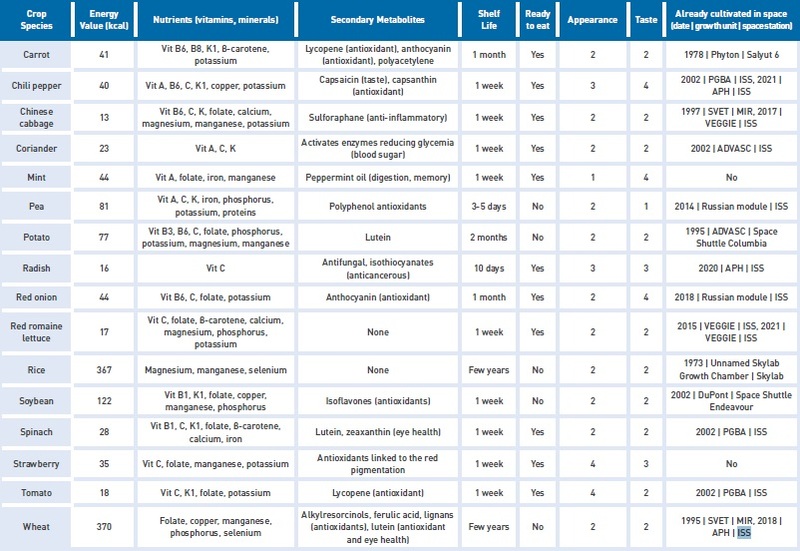 Table of different crops with their nutritional, medical, agronomic and psychological characteristics suitable for long missions in space.
Table of different crops with their nutritional, medical, agronomic and psychological characteristics suitable for long missions in space.
Growing plants in a spacecraft
Space presents two major sources of stress for plants: cosmic radiation and microgravity.
Radiation affects plant growth negatively and increases the risks of genetic mutations, so protecting plants from radiation should be a priority. While radiation can be contained using lead and/or water shields, this represents an additional mass to place in orbit. A good solution, which originated from Lockheed Martin’s Mars Base Camp (2018), is to use fuel storage as a radiation shield.
Microgravity, on the other hand, does not impair plant growth significantly, though it might slow it down. However, the plant’s response differs according to the species, as microgravity affects the plant’s genome expression. It has been discovered that, in microgravity, plants will express more stress-related genes, such as heat-shock genes, and increase their production of stress-related proteins. Moreover, seeds have been found to have different concentrations of metabolites and delayed germination.
Microgravity also affects the plant’s microenvironment, such as the lack of movement of the atmosphere, creating an unusual atmospheric composition and difficulty in watering (with or without support). There is no air convection in outer space, so if the growing station is not sufficiently ventilated any gas emitted by the plant will remain around its surface. It has been shown that the accumulation of gaseous ethylene around plants’ leaves results in abnormal leaf development. Other gases, like carbon dioxide, present in high concentrations in a spacecraft, can be lethal to some plants. The same problem arises for plant watering, so developing a method that does not drown the roots will be needed.
The plant’s response to the space environment is more difficult to evaluate. Some aspects of that environment, such as restricted space, can direct our choice toward dwarf varieties. However, some other aspects like the plant’s response to microgravity vary depending on species and varieties. Although experiments need to continue, a certain number of plants have already been tested and described as able to grow in space and we can use them as a basis.
The development of a self-sustaining plant chamber covering all the nutritious needs of astronauts could take decades but using small chambers as complementary measures could help the crew with deficiencies in vitamins and nutrients (which are altered in packaged food) and reduce diet fatigue.
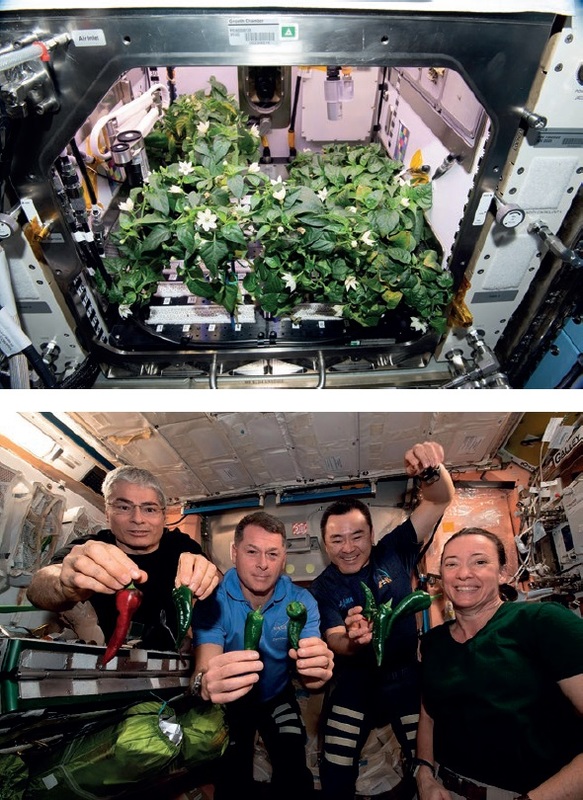 Mark Vande Hei, Shane Kimbrough, Thomas Pesquet, Akihiko Hoshide and Megan McArthur of the Space X Crew-02 posing with their harvest of red and green chili peppers in the ISS in 2021 for the Plant-Habitat 04 investigation.
Mark Vande Hei, Shane Kimbrough, Thomas Pesquet, Akihiko Hoshide and Megan McArthur of the Space X Crew-02 posing with their harvest of red and green chili peppers in the ISS in 2021 for the Plant-Habitat 04 investigation.
Bioregenerative life support system
Eating freeze-dried food at every meal creates menu fatigue and astronauts tend to eat less over time
In a spacecraft, room is limited. Therefore, the success of the mission depends on regenerative systems embedded into Life Support Systems (LSS) which can recycle used matter into usable matter. The Environmental Control and Life Support System (ECLSS) installed in the International Space Station (ISS) produces oxygen and water by recycling carbon dioxide and urine; a similar system will be needed for long spaceflights.
The idea of a bioregenerative LSS (BLSS) was born in the 1960s to include food production and the recycling of waste materials (for example, faecal matter) to the ECLSS. A BLSS with bacteria and algae could be used to recycle the nitrogen in solid wastes back into a usable form of organic nitrogen that plants could absorb. An experiment following that principle – the Micro Ecological Life Support System Alternative (MELiSSA) – has been developed and conducted by the European Space Agency since the 1990s.
However, as we include higher plants in the BLSS, we will need to study their integration with the other existing environmental control technologies, which represents a new challenge. Determining the cost and the sustainability of these smaller food-crop production systems will provide critical information for evolving toward a larger BLSS.
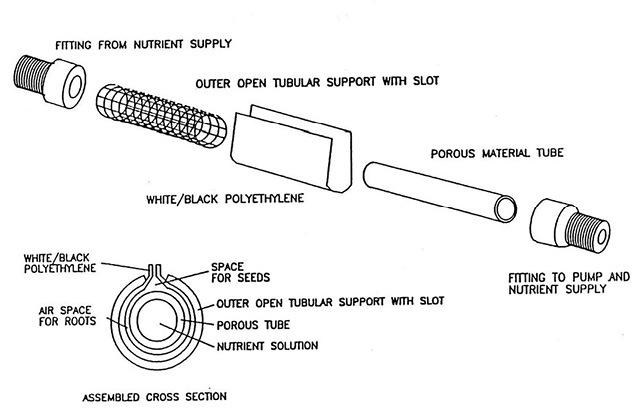 Schematic diagram of the second design of the porous tube plant growth unit.
Schematic diagram of the second design of the porous tube plant growth unit.
Developing a plant growth chamber
Using a hydroponic system to grow crops is an attractive possibility, as it grows plants in water instead of relying on a soil-like system. The latter adds weight to the spacecraft and the risk of particles floating around, two aspects that make it disadvantageous. The Advanced Plant Habitat (APH) installed in the ISS has already grown a variety of dwarf wheat using a hydroponic system with a porous tube watering system embedded in a root module containing arcillite and a slow-release fertiliser.
To ease the crew’s horticultural activities and to ensure that plants are growing in an optimal environment, the crop cultural cycle needs to be fully monitored by a computer. Such a monitoring system was tested in 2018 in Antarctica. Using a partly automated system for growing crops will ensure that the crew benefits from the presence of plants in the spacecraft (by manipulating them) and avoids the issue of agriculture becoming too time-consuming. Indeed, the room needed to grow plants is not yet precisely defined and several experiments in space-like environments (like the HI-SEAS) have shown that this activity can become lengthy.
Growing plants has been proved to have tremendously beneficial effects, as it can give the astronauts a feeling of travelling with a piece of Earth
Finally, NASA’s Vegetable Production System, or Veggie, (launched in 2014), which provides a growing area of 0.11 m², is a great example of a plant growth unit that could be used onboard a spacecraft, as it has already been tested on the ISS. In terms of light requirements, LEDs are used with two different wavelengths: red (630 nm) and blue (455 nm) as plants grow more efficiently under these wavelengths. A green LED might also be necessary to give the plant its natural colour, thus easing the identification of diseases and reminding the crew of Earth.
 Mizuna (Japanese cabbage), red romaine lettuce and Tokyo bekana (Chinese cabbage) grown in Veggie unit in the ISS.
Mizuna (Japanese cabbage), red romaine lettuce and Tokyo bekana (Chinese cabbage) grown in Veggie unit in the ISS.
Space conditions create stress for both humans and plants, so the design of plants able to grow in spacecraft and help alleviate some of the stresses that astronauts experience is currently being studied.
Genes involved in plants’ stress responses have been identified but to reduce or mitigate those effects scientists need to modify the expression of existing genes or add space-adaptation genes into the genomes. This can be achieved using gene editing and some candidate genes have already been specifically identified and studied. For example, ARG1 (Altered Response to Gravity 1), a gene known to affect gravity responses in plants on Earth, is involved in the expression of 127 genes related to spaceflight adaptation. Most of the genes altered in expression in spaceflight were found to be Arg1-dependent, suggesting a major role for that gene in the physiological adaptation of undifferentiated cells to spaceflight. HsfA2 (Heat Shock Factor A2) has a significant effect on spaceflight adaptation, for example through starch biosynthesis. The objective is to impair stress-inducing genes and promote beneficial ones.
Other genes, called space-adaptation genes, such as genes related to radiation, perchlorate, dwarfism and cold temperature, are potentially worth studying as they would help plants resist the harsh conditions of space. For example, microorganisms adapted to hypersaline environments possess genes for UV resistance and perchlorate resistance. Many dwarf varieties (e.g. of wheat) have already been cultivated on the ISS and the dwarf cherry tomato ‘Red Robin’ might be grown in the ISS as part of NASA’s Veg-05 experiment.
We can also design plants for astronauts’ health. Promoting the accumulation of beneficial compounds, making whole-body edible plants to reduce waste, or designing plants to produce drugs against space’s side effects on astronauts are possible ways to make plants useful for the crew.
A Whole-Body Edible and Elite Plant (WBEEP) strategy was used on potato plants, making potato stems and leaves edible by removing the solanine from them. To inhibit its production, either the genes producing it are silenced or mutated by gene editing. Creating this WBEEP potato has advantages as it is an easily cultivated plant that is a good source of energy and has proven able to grow in difficult conditions such as space. The plants were also fortified to fully meet the human body’s nutrient needs.
Radiation affects plant growth negatively and increases the risks of genetic mutations, so protecting plants from radiation should be a priority
One of the main issues for astronauts’ health in microgravity is bone density loss. Our bones are constantly balanced between growth and resorption, allowing bones to respond to injury or changes in exercise. Spending time in microgravity disrupts this balance, tipping bones towards resorption, so astronauts lose bone mass. This can be treated with a drug called parathyroid hormone, or PTH, but it requires regular injections and has a very short shelf life, which is problematic for long spaceflights. Therefore, a transgenic lettuce that produces PTH was engineered.
Designing plants able to grow in space and be of use for astronauts is still in its early stage of research. However, its prospects are very promising and are being studied by all major space agencies. Building a plant growth chamber in the unwelcoming environment of space still requires work. One of the challenges will be to add the bioregenerative part of the BLSS to the already existing LSS. Another challenge is the need for a better choice of crops to be grown on board to both withstand space conditions and offer significant yields. But thanks to the spread of knowledge in plant breeding, gene editing in the chosen crops will allow them to be further adapted to space conditions and match the nutritional and health needs of a crew.
A source: https://room.eu.com


